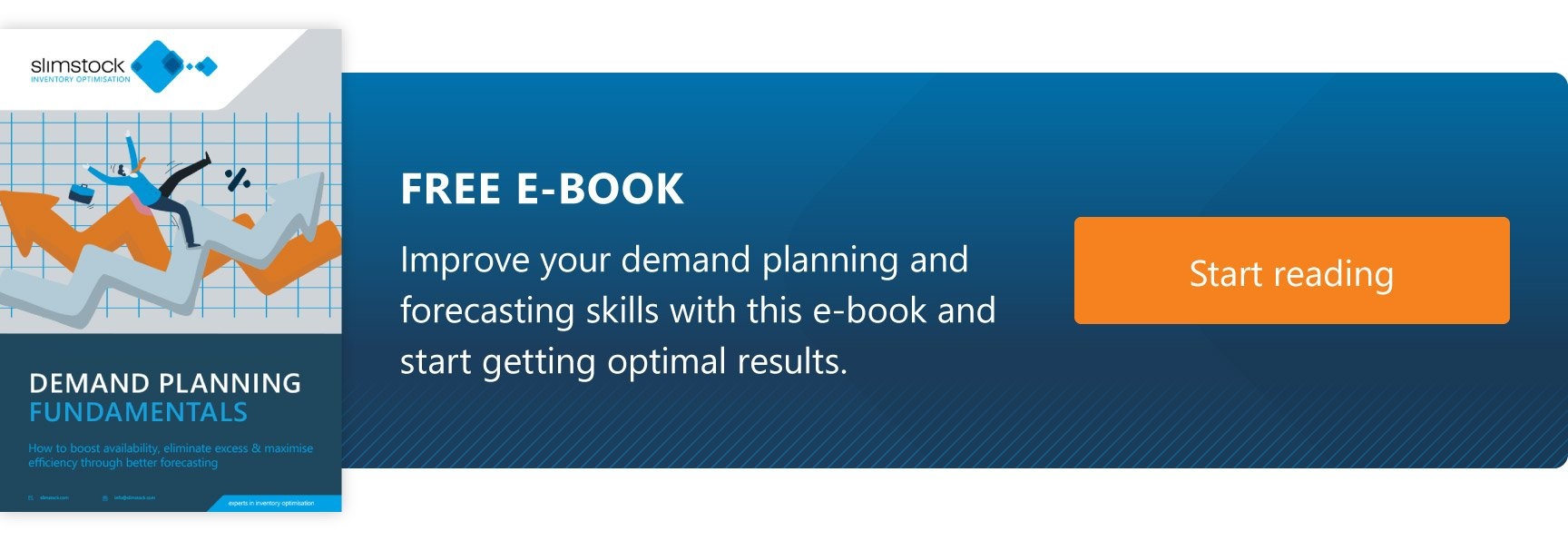Table of contents
Table of contents- Inventory Cost – The Ultimate Guide to Reducing Costs and Boosting Profits
- Inventory costs will surprise you
- How to calculate inventory costs?
- How to calculate total inventory costs? A working example…
- What potential ROI you can expect by reducing inventory?
- What hurdles do you need to overcome to cut inventory costs?
- Reducing inventory for slow & non-movers
- What practical steps can you take today to make this a reality?
- Inventory cost key takeaways
- Inventory cost FAQs
Inventory costs will surprise you
Inventory is a necessary evil. After all, to keep customers happy, you need the right stock, at the right time. But how much inventory do you need? And more importantly, what’s your inventory cost in real terms?
From the cost of purchasing the inventory in the first place to storing it in your warehouse, and moving it throughout your network, inventory costs start building from the moment you place the order. The problem is, that most businesses have no idea just how much their inventory is costing them every day!
But what if you could change this? What would happen if you reduced your inventory by 10, 20 or even 30%?
Balancing the books
Holding too much stock has some potentially disastrous financial consequences. After all, money tied up in inventory cannot be used anywhere else.
Furthermore, capital tied up in items that you can no longer sell (e.g., obsolete stock) may be lost forever.
However, poorly invested working capital is not the only concern. There is a range of additional costs associated with holding inventory which must be taken into account.
For example, your business may have to pay interest if money was borrowed to buy the stock in the first place.
Additionally, you will have to pay for warehouse space as well as invest in tools & equipment to keep things running smoothly. Moreover, you will have to pay people to physically manage this stock.
All of these things combined come at a great cost to the business. But how much exactly?
What’s the size of the prize?
By adopting more effective inventory practices, businesses can attain significant reductions in inventory. As an example, many of our customers attain up to 30% reductions in inventory within just 12 months of launching their optimisation project with many enjoying continuous year-on-year inventory reductions long after the initial project is complete.
Sure, some of the benefits of reduced inventory are obvious. For example, free up space in the warehouse, reduce waste, and improve cash flow. But the full extent of the reward may surprise you.
In this whitepaper, we will explore how to calculate the true cost of your inventory as well as its impact on your cash flow.
Ultimately, in this whitepaper, we will reveal:
- How to calculate your current inventory holding costs?
- What potential ROI you can expect by reducing inventory?
- What hurdles do you need to overcome to cut inventory costs?
How to calculate inventory costs?
If you are a wholesaler, retailer or any type of company that holds inventory, many of the costs you incur will in some way relate to the items you have in your warehouse. However, we will limit ourselves to three main cost components of the inventory cost formula:
- The cost of capital
- Inventory handling costs
- Inventory risk costs

1. The cost of capital
What is the cost of capital?
Capital costs are the costs that a company will encounter when borrowing money.
In many businesses, the inventory is financed through many means including shareholder equity, bank loans and other sources of capital. And of course, this money is never free!
However, the cost of capital can differ hugely depending on the situation.
For instance, if a director or major shareholder was to invest money into the business, they may accept a 5% return on their investment. An investment company, on the other hand, may expect to see a return of something more like 25%.
If the money used to finance the stock investment is borrowed from a bank, the cost of capital will depend on the given interest rate.
An objective way to measure how a company is financed is the so-called Weighted Average Cost of Capital (WACC). According to a 2021 report from KPMG, the WACC for European businesses is typically between 7-9% (after corporation taxes).
In simple terms, the cost of capital to hold inventory is a significant expense, to say the least!
2. What is inventory carrying costs, Inventory handling & stock holding costs
The next set of costs we will explore are the so-called handling & holding costs. These are defined as the costs that are incurred from the moment the goods are controlled by the business until the moment that they are sold.
You can calculate these costs in two ways depending on whether or not the cost components are fixed or variable.
What are variable costs?
These are the direct costs associated with the inventory. These typically include the costs to pick, pack and transport the inventory among other things.
Variable costs increase in direct relation to the level of inventory you hold. For example, if a business increases its inventory levels, the variable handing costs will also increase.
If you have outsourced your warehouse activities, the variable inventory costs are easy to determine. These costs usually refer to the cost per pallet charged by the service provider. However, these costs will vary between different service providers.
You have to take into account the fact that you will have to pay a fee per pallet each week. There will also be costs associated with the administration of goods in and goods out but we will not consider these costs here.
Total costs of £150-200 per pallet are not uncommon but these numbers will need to be verified for specific circumstances.
It is common to calculate the outsourced costs as a percentage of inventory value. For example, if your inventory has a purchase value of £1,000,000 and the service provider may charge 10%. Therefore, your costs will be £100,000 annually.
Alternatively, you can calculate variable handling costs yourself. However, you must consider all of the relevant costs: rental of your property, depreciation of equipment such as shelving and storage systems, energy costs and personnel costs, etc. You then must come up with a formula that allows you to allocate these costs to your inventory. There are various business economics techniques available.
If you keep all of your warehouse operations in-house and do not outsource, it is advisable to calculate the handling costs yourself. However, if you are not able to do this, a practical solution is to base an estimate upon the costs that a logistics service provider will charge for this. With just a few calls, you should be able to get a good understanding of the costs involved.

What are fixed inventory costs?
Fixed inventory costs are fixed in that they do not change as inventory levels fluctuate. Examples of inventory costs include the contractual obligations for lease payments on warehouse space or warehouse staff salaries. For example, if a business has a 5-year lease on a distribution centre, the business will continue to pay the monthly lease fees regardless if the warehouse is empty or full to the rafters with stock.
Businesses that base their warehousing operations on their premises tend to look at the total cost of the space. The reasoning for this is that the warehouse and the staff are already in place and that whether there is more or less stock, this will have little or no effect on overall costs.
This approach, however, can result in a distorted picture which, in turn, can result in poor stocking decisions. After all, inventory costs are not only important for your bottom line, they are also an important parameter when calculating order volumes.
The formula of Camp calculates the optimal order size based on average demand, cost of purchasing, selling price and inventory costs. Consequently, if you just pretend that the space costs are nil, the order sizes will soon rise, and therefore the inventory and the corresponding capital investment will also increase.
3. Inventory risk costs
The third component is the inventory cost that is associated with risk. The bulk of this comes as a consequence of obsolescence. However, this cost also encompasses things like insurance costs which cover the business in the event of fire or theft, for example.
In principle, these costs are easy to determine. In many businesses, the CFO will determine the so-called “provisions for obsolete inventories” each year. This ultimately outlines the minimum risk rate.
Suppose the stock is worth £1 million and the CFO reserves £50,000 per year for depreciation of the inventory. Then the costs associated with risk will amount to at least 5%. On top of this, insurance fees have to be paid. And there are always costs associated with damage, spoilage, and theft.
How to calculate total inventory costs? A working example…
Total annual inventory costs are typically expressed as a percentage of the inventory value.
So, let’s assume our inventory value is £5 million.
In this example, the cost of capital is 8%, the handing & holding costs are 10%, and the risk costs equate to equate 5%.
Suddenly, the total inventory cost comes to a scary amount!
| Total Inventory Value: £5m | Cost as % of Total Inventory Value | Actual Cost |
| Cost of Capital | 8% | £400,000 |
| Risk Costs (Obsolecense, depreciation, Insurance) | 7% | £350,000 |
| Total Costs | 25% | £1,250,000 |
With an inventory value of £5m, the real monetary cost of our inventory is £1,250,000. To put things into perspective, this is over £3500 every day!
Of course, the % for each cost element may differ for your business. However, you may still be shocked by just how much your inventory is really costing.
Top tip: Working capital is one of the most valuable assets within your business. Therefore, its vital that you invest it wisely. Find out how well this invaluable resource is managed within your business with our 10-step checklist to working capital management.
What potential ROI you can expect by reducing inventory?
Through effective inventory management, businesses can significantly reduce inventory costs while improving service to customers.
Though anticipating demand with greater accuracy, making smarter orders, improving the reliability of the supply chain, utilising ABC classifications and gaining greater control over product lifecycle management, businesses can attain an inventory reduction of up to 30%!
Imagine if you could reduce that £5 million of inventory by 30%. Instead of holding £5 million of inventory, you are now only holding £3,500,000.
In this case, the cost savings will be £875,000 (new inventory value of £3,500,000 X the total inventory costs of 25%).
Furthermore, you will have released an additional £1,500,000 of working capital back into the business.
The benefits do not end there. Just by reducing costs while maintaining the same level of sales, profit margins will inevitably improve. As a strong indicator of the health & value of a business, this will be music to the shareholder’s ears!
Top tip: To reduce inventory costs, you may have to make some strategic investments. Perhaps you implement a more advanced inventory solution or maybe you grow you planning team. Here are a few tips to help you asses if these investments are worth it. Click here to read our guide to ROI analysis.
What hurdles do you need to overcome to cut inventory costs?
The cash flow & profit margin gains are seductive. However, these results are not guaranteed.
Whether you can actually redeem these cost savings and cash flow benefits depends on how much surplus inventory has built up. It also depends on whether the items in question are ‘fast movers’, ‘slow movers’ or ‘non-movers’!
In this section, we will explore why these factors may prevent or limit your ability to reduce inventory levels.
Reducing inventory for fast-moving items
Suppose you realise a stock reduction of £1.25m by reducing the inventory of fast-moving items. How would this benefit your business?
To keep things simple, let’s use SKU 1234 as an imaginary example:
The average demand for this item is 1000 units per week with a purchase price per unit of £100. At present, there are on average 6,000 pieces of SKU 1234 in stock. Therefore, the inventory value is £600,000.
Thus, with inventory costs equating to 25%, the annual inventory cost to hold SKU 1234 is £150,000.
Now imagine that you can reduce this stock by £300,000, reducing the average units on hand from 6,000 to 3,000 units. Better still, you achieve this while maintaining exceptional service to the customer.
If the inventory costs were completely variable, then the above action would save you £75,000 on an annual basis (£300k x 25%)
If only reducing inventory costs was this easy…
Unfortunately, you will never realise this in practice. In the case of fast-moving items, it is not right to calculate the cost of obsolescence. This is because these products are almost certain to be sold. Furthermore, fixed costs will not be decreased immediately.
After all, the released pallet locations are unlikely to be reutilised straight away and the immediate impact on the staff will also be relatively low. In short, we cannot count on the full 25% of inventory cost reduction, but only with the 8% capital cost.
Even then, the annual savings are significant, namely £24,000 (£300k x 8%).
But there is a more important benefit and that’s the effect on your cash flow! If you can lower your on-hand inventory from 6,000 to 3,000 units, you need to buy 3,000 fewer unit pieces.
And that immediately generates 300,000 euros of freed-up working capital (3,000 units x £100 purchase price)!
This money can, therefore, be invested directly into new equipment, other machines or other useful purchases. This has a hugely positive effect on cash flow and makes the inventory reduction project even more attractive.
Reducing inventory for slow & non-movers
For slow-moving items, where we only make a few sales now and then, it could take a long time before we can start to reap the rewards of reduced inventory.
However, if the inventory reduction of £300,000 is achieved purely through non-movers, the outcome will be very different.
Demand for these articles is zero, yet there are still 3,000 units in stock.
If we declare this stock as obsolete and throw it away, financially, nothing happens. After all, the products are worthless.
Furthermore, in terms of cash flow, nothing will happen. In fact, in some cases, throwing items away can come with a cost. For example, if you are disposing of chemical liquids, there will be removal costs.
Nevertheless, it is vital to clean up this obsolete. Otherwise, we will continue to incur inventory costs forever!
Top Tip: Separating your slow & non movers from your fast-moving items requires robust analysis. Thankfully, effective forecasting can help bring transparency to the decision-making process. Click here to find out how you attain a clearer picture of future demand with our complete guide to demand planning.
What practical steps can you take today to make this a reality?
Reducing inventory levels is easier said than done. There are lots of factors that impact the extent to which you can shrink your inventory holding.
However, if you can successfully cut inventory levels down to size, the potential cost savings are huge. And if you can achieve this while maintaining or even improving service to customers, this will provide a huge boost to your cash flow!
Kick-start your cost optimisation journey. Check out our guide to inventory optimisation management.
Inventory cost key takeaways
Inventory costs can be a significant financial burden for businesses. From the cost of purchasing inventory to storing it, moving it, and managing it, the expenses start accumulating from the moment the order is placed.
Holding too much stock can have negative financial consequences, tying up capital that could be used elsewhere. Additionally, holding obsolete stock can result in lost money.
Inventory costs can be broken down into three main components: the cost of capital (borrowing money to finance inventory), inventory handling costs (direct costs associated with inventory), and inventory risk costs (associated with obsolescence, insurance, etc.).
By adopting more effective inventory practices, businesses can achieve significant reductions in inventory. Some companies have seen up to 30% reductions in inventory within 12 months of implementing optimization projects.
Reducing inventory can free up warehouse space, reduce waste, improve cash flow, and lead to improved profit margins.
However, reducing inventory is not without challenges, especially for slow-moving and non-moving items. For fast-moving items, reducing inventory can lead to immediate cost savings and improved cash flow.
To achieve inventory reductions successfully, businesses need to make strategic investments, implement effective inventory management practices, and forecast demand accurately.
The potential cost savings from reducing inventory can be significant, leading to improved cash flow and better overall financial health for the business.

Inventory cost FAQs
What are inventory costs?
Inventory costs involve the expenses associated with purchasing, storing, and managing inventory throughout the ecommerce supply chain. The cost of inventory goes beyond the initial purchase, including storage costs, as well as the costs of holding unsold finished goods.
Why is inventory cost important?
Assessing inventory costs is essential and has flow on effects on the finances of a company as well as on its management. It can help businesses determine how much profit can be made on inventory, how costs can be reduced, where changes can be made, how suppliers or items can be chosen and how capital can be allocated.
What is the Inventory cost formula?
Inventory Cost = (Beginning Inventory + Inventory Purchases) – Ending Inventory.
What are the 4 main types of inventory?
The four major ones are raw materials and components, work in progress, finished goods and maintenance, repair and operating supplies.
What are the three main cost components of the inventory cost formula?
The three main cost components of the inventory cost formula are: cost of capital, inventory handling costs, and inventory risk costs.
How is the cost of capital related to inventory costs?
The cost of capital refers to the expense a company incurs when borrowing money to finance its inventory. The cost can vary greatly depending on the source of funding and its related interest or return rate.
What are inventory handling costs and how are they calculated?
Inventory handling costs refer to the expenses incurred from the moment the goods are under a business’s control until they are sold. They can be calculated either as fixed or variable costs. Variable costs increase with inventory levels and can include the costs to pick, pack and transport the inventory. Fixed costs remain constant regardless of inventory levels and can include lease payments or salaries.
What is the potential Return on Investment (ROI) when reducing inventory?
By effectively managing inventory and reducing its levels, businesses can achieve significant cost savings, improved cash flow, and potentially higher profit margins. The exact ROI will depend on the initial state of the inventory and the efficiency of the implemented inventory management practices.
What happens when you reduce inventory for slow or non-moving items?
Reducing inventory for slow or non-moving items might not have immediate financial or cash flow benefits, especially if these items are obsolete and have no market value. However, this can free up storage space and potentially reduce risk costs in the long term.
Can inventory costs be completely eliminated?
While it’s not possible to completely eliminate inventory costs, businesses can significantly reduce these costs by adopting effective inventory management practices, accurately predicting demand, making smarter orders, and improving supply chain reliability.









